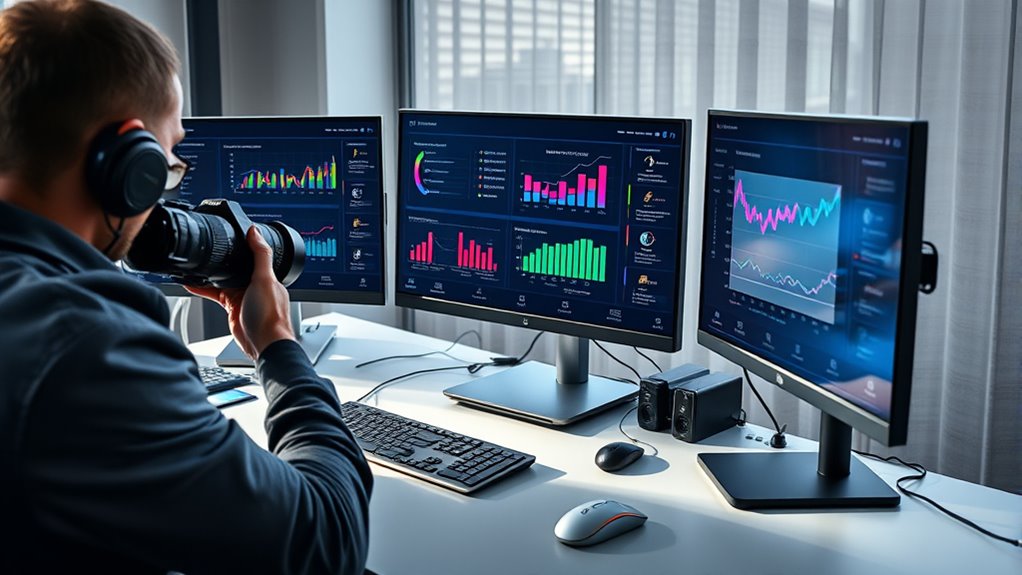To master Core Web Vitals, focus on optimizing your critical rendering path by prioritizing essential resources, deferring non-critical scripts, and compressing assets. Use advanced lazy loading with placeholders to delay off-screen content until needed. Fine-tune server responses with CDN caching and HTTP/2, while managing layout shifts by reserving space for dynamic elements. Keep monitoring performance regularly to identify and fix issues—continue exploring these strategies for lasting improvements.
Key Takeaways
- Prioritize critical rendering path optimization by inline CSS and asynchronous scripts to reduce initial load delays.
- Implement advanced lazy loading with Intersection Observer and placeholders for images and off-screen content.
- Leverage CDN caching and HTTP/2 prioritization to accelerate resource delivery and minimize server response times.
- Use layout stability techniques like size attributes and CSS containment to prevent unexpected shifts during load.
- Continuously monitor real-time metrics and user feedback to refine performance strategies and ensure ongoing stability.
Optimizing Critical Rendering Path for Faster Load Times

To improve your website’s load times, you need to optimize the critical rendering path. Focus on resource prioritization to ensure essential assets load first, reducing delays in rendering visible content. Identify and defer non-critical scripts and styles that don’t impact initial display, which helps minimize render blocking. By reducing render blocking, you allow your browser to quickly paint above-the-fold content, improving perceived speed. Use techniques like asynchronous loading for JavaScript and inline critical CSS to streamline the rendering process. Avoid unnecessary resource requests and compress assets to cut down on load times. Properly managing resource prioritization and render blocking reduction ensures your website becomes faster, more responsive, and provides a better user experience, ultimately boosting your Core Web Vitals performance. Additionally, integrating sound healing science principles such as calming frequencies can create a more relaxed browsing environment, potentially reducing user bounce rates. Incorporating visual harmony in layout and design can further enhance user engagement by creating a calming and cohesive visual flow. Applying content optimization strategies, like enhancing images and reducing unnecessary code, also plays a crucial role in improving load times and stability. Being mindful of projector technology advancements can inspire innovative ways to optimize visual delivery for multimedia content. Moreover, optimizing your website for accessibility ensures a broader audience can enjoy a seamless experience.
Implementing Advanced Lazy Loading Techniques

Implementing advanced lazy loading techniques can substantially enhance your website’s performance by deferring the loading of non-essential resources until they’re actually needed. Use placeholder techniques like low-resolution images or skeleton screens to give users immediate visual feedback, improving perceived load times. Prioritize resources by identifying critical content and deferring less important assets, such as images below the fold or off-screen scripts. Leverage Intersection Observer APIs to trigger resource loading only when elements enter the viewport. Combine this approach with intelligent resource prioritization, ensuring essential assets load promptly while non-critical ones load asynchronously or with delays. Additionally, consider the headphone compatibility and connection types to optimize user experience across devices. This strategy reduces initial load times, minimizes main-thread work, and boosts Core Web Vitals, delivering a faster, more stable browsing experience for your visitors. Employing performance optimization techniques can further refine your site’s responsiveness and stability, especially when considering content spoilage and ensuring only fresh, safe resources are loaded. Incorporating mindful mindfulness practices in your development process can also help maintain focus on user-centric performance goals and reduce unnecessary resource consumption. Regularly monitoring your site’s performance metrics allows you to make data-driven improvements and sustain optimal performance over time.
Fine-Tuning Server Response and Caching Strategies

Optimizing server response times and caching strategies is essential for delivering a fast, reliable website. To do this effectively, focus on these key areas:
- Implement HTTP/2 prioritization to ensure critical resources load first, reducing perceived latency.
- Leverage CDN edge caching to serve static assets quickly, decreasing server load and response time.
- Fine-tune cache headers to regulate content freshness and prevent unnecessary requests.
Enhancing Stability Through Precise Layout Shift Management

Efficient server response and caching strategies set the stage for a smooth browsing experience, but even with quick load times, layout shifts can undermine perceived stability. To enhance layout stability, focus on shift prevention by reserving space for images, ads, and dynamic content using size attributes or CSS aspect ratios. Avoid inserting content above existing elements unless necessary, and consider using CSS containment techniques to limit layout recalculations. Prioritize stable UI components that don’t move unexpectedly during page load. Regularly audit your site for unexpected shifts, and fix elements that cause layout instability. Additionally, understanding electric dirt bike horsepower can inform the placement and sizing of performance-related content, helping to anticipate and prevent shifts. Implementing content stability techniques such as placeholders and reserved space can further minimize unexpected movements. Employing layout shift prevention best practices ensures a more consistent user experience. By managing layout shifts precisely, you guarantee a more stable experience, reducing user frustration and improving your Core Web Vitals scores. This targeted approach helps maintain a consistent, reliable layout throughout the browsing process.
Leveraging Monitoring Tools for Continuous Performance Improvement

To guarantee your website maintains high performance over time, leveraging monitoring tools is essential. These tools provide real-time analytics, allowing you to spot issues before they impact users. Additionally, collecting user feedback helps you understand user experiences and identify areas for improvement. Regularly reviewing quality assurance metrics ensures your performance remains aligned with industry standards. Incorporating insights from performance metrics can further optimize your site’s responsiveness and stability. Understanding the credibility of gold dealers can also influence the trustworthiness of your investment information, paralleling the importance of trustworthy data sources in website management. Monitoring alimony laws and legal standards can help ensure compliance and adapt to legal changes affecting your site’s content. Employing essential oil benefits in your content strategy can enhance user trust and engagement by providing valuable, well-researched information.
Frequently Asked Questions
How Do Core Web Vitals Impact SEO Rankings Long-Term?
Core Web Vitals critically influence your SEO rankings because they are key ranking factors that reflect your site’s user experience. When you optimize for metrics like loading speed, interactivity, and visual stability, you enhance user satisfaction and reduce bounce rates. Over the long term, this improved user experience boosts your search engine rankings, helping your site stay competitive and attract more traffic, as search engines prioritize sites that deliver a seamless browsing experience.
What Are Common Pitfalls in Advanced Lazy Loading Implementations?
When implementing advanced lazy loading, you might encounter common pitfalls like improper resource prioritization, which delays critical content from loading quickly. Lazy loading pitfalls also include misconfiguring image or script loading, causing layout shifts or slow interactivity. To avoid these issues, guarantee you prioritize essential resources and test thoroughly across devices. Properly balancing lazy loading with resource prioritization boosts performance and stability, enhancing user experience and maintaining your SEO efforts.
How Can I Prioritize Metrics for Different Device Types?
Did you know that mobile users typically expect pages to load in under 3 seconds? When doing device comparison, you should focus on priority mapping to optimize metrics for each device type. For mobile, prioritize reducing LCP and FID, while desktop might need a heavier focus on CLS. Tailoring your performance strategies guarantees a smoother experience across devices, boosting engagement and satisfaction.
What Role Does Third-Party Script Management Play in Performance?
Third-party scripts critically impact your website’s performance. Managing these scripts involves careful script optimization, such as deferring or asynchronously loading them, to reduce load times. You play an essential role by auditing third-party scripts regularly, removing unnecessary ones, and ensuring only vital scripts run. Proper third-party script management helps improve stability and speed, enhancing user experience and positively affecting your Core Web Vitals scores.
How Often Should Monitoring Tools Be Calibrated for Optimal Results?
Every few weeks, your monitoring tools should be calibrated to keep data accurate—think of it like tuning a musical instrument. Research shows that inconsistent calibration intervals can lead to 20% inaccuracies in performance reports. To guarantee maximum results, set regular monitoring frequency and calibration intervals, ideally monthly or quarterly. This keeps your insights reliable, helping you respond swiftly to performance issues and maintain a smooth, stable user experience.
Conclusion
By applying these advanced strategies, you’ll turn your website into a well-oiled machine, seamlessly balancing speed and stability. Think of your performance optimization efforts as tuning a fine instrument—each adjustment bringing harmony and precision. Keep monitoring your progress like a vigilant guardian, ready to fine-tune your site’s performance as needed. With dedication and these techniques, you’ll guarantee your web experience remains smooth and reliable, shining brightly in the vast digital landscape.









